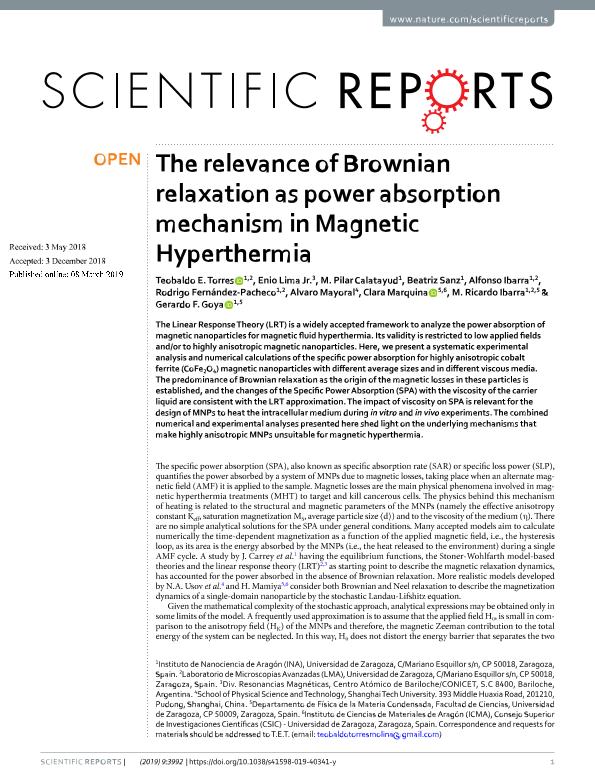Artículo
The relevance of Brownian relaxation as power absorption mechanism in Magnetic Hyperthermia
Torres Molina, Teobaldo Enrique ; Lima, Enio Junior
; Lima, Enio Junior ; Calatayud, M. Pilar; Sanz, Beatriz; Ibarra, Alfonso; Fernández Pacheco, Rodrigo; Mayoral, Alvaro; Marquina, Clara; Ibarra, M. Ricardo; Goya, Gerardo Fabian
; Calatayud, M. Pilar; Sanz, Beatriz; Ibarra, Alfonso; Fernández Pacheco, Rodrigo; Mayoral, Alvaro; Marquina, Clara; Ibarra, M. Ricardo; Goya, Gerardo Fabian
 ; Lima, Enio Junior
; Lima, Enio Junior ; Calatayud, M. Pilar; Sanz, Beatriz; Ibarra, Alfonso; Fernández Pacheco, Rodrigo; Mayoral, Alvaro; Marquina, Clara; Ibarra, M. Ricardo; Goya, Gerardo Fabian
; Calatayud, M. Pilar; Sanz, Beatriz; Ibarra, Alfonso; Fernández Pacheco, Rodrigo; Mayoral, Alvaro; Marquina, Clara; Ibarra, M. Ricardo; Goya, Gerardo Fabian
Fecha de publicación:
12/2019
Editorial:
Nature Publishing Group
Revista:
Scientific Reports
ISSN:
2045-2322
Idioma:
Inglés
Tipo de recurso:
Artículo publicado
Clasificación temática:
Resumen
The Linear Response Theory (LRT) is a widely accepted framework to analyze the power absorption of magnetic nanoparticles for magnetic fuid hyperthermia. Its validity is restricted to low applied felds and/or to highly anisotropic magnetic nanoparticles. Here, we present a systematic experimental analysis and numerical calculations of the specifc power absorption for highly anisotropic cobalt ferrite (CoFe2O4) magnetic nanoparticles with diferent average sizes and in diferent viscous media. The predominance of Brownian relaxation as the origin of the magnetic losses in these particles is established, and the changes of the Specifc Power Absorption (SPA) with the viscosity of the carrier liquid are consistent with the LRT approximation. The impact of viscosity on SPA is relevant for the design of MNPs to heat the intracellular medium during in vitro and in vivo experiments. The combined numerical and experimental analyses presented here shed light on the underlying mechanisms that make highly anisotropic MNPs unsuitable for magnetic hyperthermia.
Palabras clave:
Ferrite
,
Nanoparticle
Archivos asociados
Licencia
Identificadores
Colecciones
Articulos(CCT - PATAGONIA NORTE)
Articulos de CTRO.CIENTIFICO TECNOL.CONICET - PATAGONIA NORTE
Articulos de CTRO.CIENTIFICO TECNOL.CONICET - PATAGONIA NORTE
Citación
Torres Molina, Teobaldo Enrique; Lima, Enio Junior; Calatayud, M. Pilar; Sanz, Beatriz; Ibarra, Alfonso; et al.; The relevance of Brownian relaxation as power absorption mechanism in Magnetic Hyperthermia; Nature Publishing Group; Scientific Reports; 9; 1; 12-2019; 1-11
Compartir
Altmétricas



